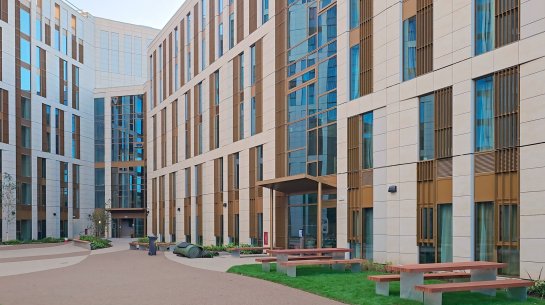News - 31-01-2024
Seamless Integration: Prefabricated Unitized Facades and Built-In Components
In the ever-evolving landscape of architecture and construction, the seamless integration of built-in components within prefabricated unitized facades represents a remarkable stride towards efficiency, quality, and aesthetic cohesion. With advancements in technology and manufacturing processes, architects and developers are harnessing the potential of prefabrication to incorporate diverse elements such as solar cells, shading systems, natural stone, and fillings directly into factory-produced facade units. This innovative approach not only streamlines the construction process but also enhances the functionality and visual appeal of contemporary structures.
Prefabricated unitized facades have emerged as a preferred choice for architects and developers seeking efficient construction solutions without compromising on design integrity. These facades consist of pre-assembled panels manufactured off-site in controlled environments, ensuring precision and consistency in fabrication. By integrating various building components during the manufacturing stage, prefabricated unitized facades offer a host of benefits that resonate throughout the construction lifecycle.
Enhanced Quality Control
One of the primary advantages of prefabrication lies in its ability to uphold stringent quality standards. By consolidating the production process within a factory setting, manufacturers can meticulously monitor and regulate every aspect of fabrication, from material selection to assembly techniques. This systematic approach minimizes the risk of errors, material wastage, and on-site discrepancies, thereby delivering superior quality components that meet or exceed industry standards.
Reduced Installation Time
Prefabricated unitized facades significantly expedite the installation phase of construction projects. Since the panels arrive on-site in a ready-to-install state, construction teams can swiftly erect the facade without the need for extensive on-site fabrication or assembly. This accelerated installation timeline not only accelerates project delivery but also reduces labor costs and mitigates disruptions to surrounding areas, making prefabrication a compelling choice for projects with tight schedules or logistical constraints.
Aesthetic Integration and Design Flexibility
The integration of built-in components within prefabricated unitized facades offers unparalleled opportunities for architectural expression and design innovation. Architects can seamlessly incorporate functional elements such as solar cells for energy generation, solar shading systems for climate control, natural stone cladding for aesthetic appeal, and fillings for thermal insulation directly into the facade units. This holistic approach ensures a harmonious integration of form and function, enabling buildings to respond intelligently to environmental, cultural, and contextual considerations.
In the realm of contemporary architecture, the fusion of prefabricated unitized facades and built-in components heralds a new era of construction innovation and design integration. By leveraging the inherent advantages of prefabrication, architects and developers can realize their creative vision while prioritizing efficiency, sustainability, and occupant well-being. As technology continues to evolve and boundaries are pushed, the seamless integration of diverse building elements within prefabricated facades promises to redefine the built environment and shape the cities of tomorrow.
Learn more about HansenUnitAl unitized facades here >>>